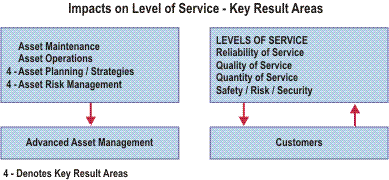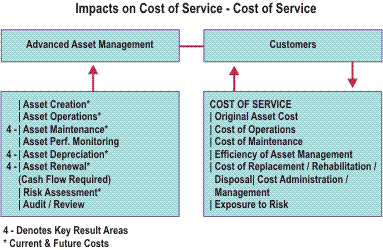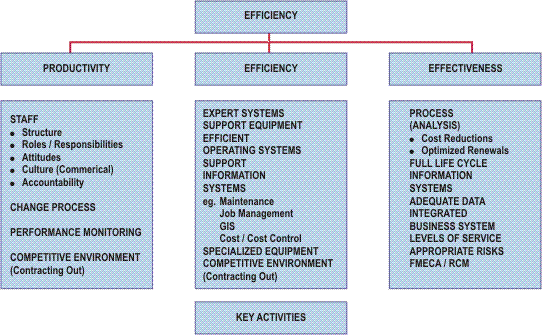Implementation
This topic covers:
The responsibility for the TAMP for each system or facility rests with its responsible manager. This includes:
- Production and maintenance of the TAMP
- Quality of the TAMP
- Application of the TAMP
- Communication of the TAMP to all operation staff
The responsibility for TAMP for all assets in a Business Unit rests with its Business Unit Manager. This includes:
- Prioritization and allocation of resources for the TAMP
- Communication of requirements for TAMP
- Assignment of duties and specific responsibilities for TAMP
- Performance review and reporting on the production, maintenance, use and cost effectiveness of TAMP.
The guidelines for asset review for the production of TAMP are the responsibility of the Asset Management Program.
Each business unit should establish a master program for asset review and production of TAMP. It should report annually its achievements against the master program. This master program should be based on an initial review of the needs for TAMP among all of the Unit's assets, and be reviewed annually for any necessary adjustments. The master program should be supported by appropriate budget and resource allocations.
Control of the breadth and depth of TAMP regulates the allocation of resources. This is critical to maximize return for the business. The limits for the breadth and depth of each asset review shall be decided by line managers and documented in the asset review project brief.
The breadth and depth of a TAMP depend on the urgency of needs and the applications for the TAMP. A routine asset review normally addresses operations, maintenance and renewal needs and strategies. Resources for this may normally be absorbed into the annual operations and maintenance budget.
An asset review incorporating master planning is usually wider ranging in scope and options. Consequently the resource demand for such a type of review is much higher, and may require justification and approval as a specific project.
To properly schedule resources for the progressive coverage of assets with review, each system may be divided up into manageable sub-systems, which then may be scheduled for a five-year review program.
While the methodologies for asset review may take time to develop, a simplified format for asset review may be adopted initially for the bulk of the assets, and a prototype asset review methodology trial may be conducted for a selected system to progressively improve and enrich the methodologies.
Asset review is a continuous key activity in asset management. An annual recurrent budget allocation should be allowed for this activity in the business plan. TAMP are the documented outcomes of asset review. Workload indicators, e.g. cost as a percentage of the asset value or the type of output required, shall be developed from the TAMP to assist the estimation of budget requirements for asset review.
The support resources required for asset review and TAMP production/ maintenance should be identified for each asset review project. The allocation of resources shall be done within the current business constraints. The performance of the resources combination shall be reviewed and optimized.
TAMP Reviews should be carried out as part of a continuous improvement process. These reviews might include the following features:
- The production, use and maintenance of TAMP and the planning and scheduling of asset review activities, shall be subject to review
- The objectives of the review are to provide an independent view on asset management accountability, identify opportunities for improvement and promote the sharing of information about asset reviews and TAMP
- The review shall focus on the asset review methods and the output quality and contents
- A review team should come from the business area concerned and may comprise peer group members, a facilitator and an independent asset management expert.
The commercial reality of asset management is that, once standards of service required by customers have been set, this standard needs to be delivered at the lowest possible cost.
If customers are willing to pay more for the service then a profit can be made. If the lowest cost still exceeds customer ability or willingness to pay, the level of service needs to be reduced, or other appropriate action taken.
Delivering infrastructure and asset services at the lowest possible cost is a blend of productivity, efficiency and effectiveness.

The types of activity that can result in savings being achieved in each of these areas are show below:

Cost Reduction Opportunities

Any activity undertaken in the field of Asset Management must be benefits driven:
- Identify potential benefits
- Analyze the opportunities to derive same
- Trial the proposal and check actual returns
- Adopt if appropriate.
The key result areas in reducing the cost of asset services are:
- Reduce life cycle service delivery costs for all activities including:
- Administration
- Finance
- Technical (design, construct, acquire)
- Operations
- Maintenance
- Renewal/rehabilitation
- Replace/disposal.
- Other key areas are:
- Non-performing assets
- Non-core assets
- Zero based budgeting for operations and maintenance.
- Causal analysis, such as:
- Analyzing the cause of failure and developing strategies to avoid or reduce the impact of this.
- Activity based analysis, to:
- Analyze the cost of every key activity needs to overcome the cause of our expenditure. Try to optimize the activities to reduce the costs.
- Analyze and assess the optimized renewal strategy (or life cycle cost) for assets including:
- Non asset (management) related options
- Asset related options such as: augment, rehabilitate, replace, operate differently, maintain differently.
This best practice approach is primarily directed at those authorities who have the potential to be viable/profitable commercial enterprises.
Some authorities feel that advanced asset management is not of high priority at present due to their poor (current) return on assets.
Before any logical gains can be made, more analysis is required to determine those areas were costs can be reduced. This cannot be done logically without further improvements in the technical and financial management of these assets.
In short, improved asset management (analysis) is essential to the future of these Authorities.
In these cases the following activities can indicate the lowest likely cost that can be communicated to customers and some idea of future usage and likely costs can then be determined.
- Move recurrent operations and maintenance into a zero based budgeting environment. If operations and maintenance activities do not derive a benefit then their need should be reconsidered. This process needs to be completed early because unjustified maintenance costs may influence the assessment of non performing assets
- Identification and disposal or rationalization of non performing assets or those assets with significant future liabilities
- Deferral of all new works that are not self funding and profitable. For example, low positive cost/benefit at 15% discount rate
- Deferral of all rehabilitation and replacement works that don't offer the same returns as above. Care needs to be taken to properly assess business risk.
The appropriate level of cost reduction to be adopted should be determined following a logical process of customer consultation.
Effect of improvement strategies on renewals and TAMP
There is considerable opinion in economic circles that the adoption of cost reduction strategies into a TAMP should only occur when those benefits that can be clearly identified and verified. This means that authorities must not only establish formal life cycle asset management plans but these plans must be proven and be capable of being implemented.
It is considered that future TAMP must be based on:
- Known and proven technology
- Current construction and rehabilitation costs
- Current maintenance programs or those proven by detailed strategic analysis
- Current or contracted materials and services costs, e.g. energy etc.
One of the key effects of improvement plans on renewals is in the assessment of appropriate intervention techniques part way through an assets life cycle. Such techniques include changes to maintenance practices or the implementation of appropriate rehabilitation.
Where these actions indicate a potential benefit to the organization, considerable work may need to be carried out before an appropriate degree of confidence can be determined, and the maintenance or rehabilitation programs can be taken into account in the adjustment of annual annuity figures.
The degree of confidence should progressively increase as improvement plans are implemented.
Typical increases in confidence levels (expressed as percentages) which may be derived as program proceed are indicated below:
- Outputs of total asset management plans
- Potential cost savings identified in future renewal programs (25%)
- Potential cost savings in operations or maintenance areas
- Detailed analysis of potential benefits (savings) through R&D (50%)
- Research and development programs outcomes implemented (65%)
- Pilot schemes implemented and outcomes assessed
- Benefits identified (80%)
- Results from full-scale implementation programs with firm contract rates or detailed costing available (100%).
Having established the initial TAMP you will now have a better idea of the ability of your organization to meet the level of service required (expected) and what that will cost.
Then the pressure will be applied to reduce costs to the lowest possible, however another option that should be considered is increasing income.
There are many actions that an asset owner can take to improve the situation in relation to the return or cost effectiveness of their assets, namely:
- Improve the utilization of the asset and therefore distribute the standard charges (capital) more evenly
- Increase the income recovered on the asset to match the true costs of operation, maintenance and consumption (depreciation).
There are many ways to increase the income on an asset and to move into a user pays or total cost recovery situation however, this will usually be dependent on the political situation that exists.
In most cases this can be best done by gradually increasing costs over a period of time to match the actual expenditure required for those assets. This can usually be done when service authorities have a sound understanding of the future cash flows required for their assets and can therefore educate their customers of the problems associated with it and the need to increase income. In many cases they can bring about a shift in resources, which may provide income for the assets concerned. In other cases they may need to be more open and sensitive in their approach.
For example, the asset owner may have the opportunity to increase incomes through raising the cost of service in line with any level of service changes that may occur.
For example:
- Increased water system capacity means that people on high hills get full pressure at peak hour. Should they pay a higher water rate?
- The water treatment plant is upgraded to provide better quality water. Shouldn't we take this opportunity to change the price of our water?
The key to this area of business development (improved profitability) is to link the level of service provided to the cost of service.
But what if we don't provide the same level of service to all customers? If we have an equal service policy then don't those who do receive services outside the contracted level receive a discount? The answer is yes.
Service contracts with customers should include a return or discount equivalent to the loss of service experienced. This approach then provides a real cost driver in our failure costing system.
The other area of income generation comes from full costing of service and relating this to system or facility income generation. The profitability of the various system components.
The identification of the actual return on assets enables us to identify non-performing assets. In some cases it may warrant changing the "cost of service" for services provided by these systems, eg, the provision of water supply to high-level areas.